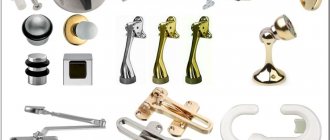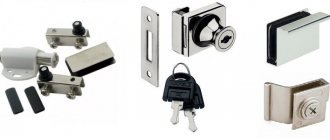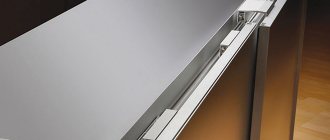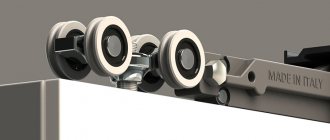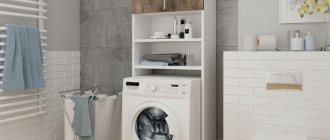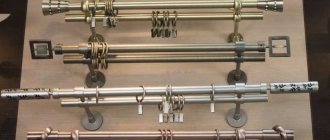Accessories
Currently, a door opening limiter is in demand. Such popularity is due to their functional purpose; such products provide reliable protection of the wall surface from impacts from the door during a strong opening. Therefore, in order not to see crumbling plaster on the floor or damaged expensive wall decoration, be sure to leave a wall or floor stop.
In addition, this door accessory will help you avoid troubles with your neighbors due to the loud knock of the door against the wall. There are several types of such devices: wall and floor stops. These products differ from each other in the material used in production, construction and design.
Floor and wall door stops
If you do not limit the movement of the door, the handle installed on it may damage the wall covering when opening.
To avoid this, you need to install a door stop. Depending on the installation location, they are divided into floor and wall. In addition, opening limiters for interior or entrance doors may differ in design, that is, they can be stationary or mobile (portable). Which type to choose depends on both your preferences and layout features. The design of these simple, but at the same time very useful devices is quite simple, so making them yourself is not difficult, the main thing is to find a little free time and patience for this.
Floor stopper
The best option for most rooms is a stationary floor door stopper. You can also make it yourself. At its core, this design is very simple, so you will need a minimal set of tools. Let's consider two options:
- Wood . Take a small block, preferably round in cross-section. Measure the required distance. You can make a stopper with a height of 3-5 cm, or you can increase it to 10 cm. If you are using pure wood, then you need to immediately treat it with stain of the desired shade and open it with varnish. Please note that the entire surface of the part must be thoroughly sanded. Then take a double screw or pin and screw it in from the back end. For installation, you need to select a place on the floor, drill a hole, insert a dowel and drive the stopper there, gradually tightening it to the very end.
- Metal . The principle of creating such a limiter is the same as for a wooden model, but there are some subtleties here. First you need to cut the tube to the desired size. An excellent option is stainless steel. For the top of the limiter, take a plastic plug. Secure the plate on the reverse side using screws. The installation principle is as follows: select a place on the floor, drill holes for the plate and secure it with screws.
Types of floor stopper for doors
To prevent the edges of the door leaf from hitting the stopper, additionally secure rubber bands to it. For example, you can take plumbing volumetric gaskets.
A door stopper is an excellent option for protecting the door leaf itself and nearby objects from damage. In addition, it can become a stylish addition to the interior, especially if you do everything yourself, taking into account your personal wishes.
Types of limiters by type of installation
There are only two types of door locks:
- Floor-standing. These stoppers secure the door in the open position. Serve as door opening degree controllers. Floor stoppers are also divided into several types: mobile - they do not need to be installed, just put them under the floor at the right time; stationary - a magnetic or rubberized stopper that limits the movement of the door.
- Wall stops are regulatory elements that provide a given door opening width. Most often, such structures are equipped with magnets.
Photo 2 Types of door limiters.
Manufacturing and installation of door magnetic lock
We prepare three nuts, two metal washers and a round neodymium magnet.
You will need to glue two pairs of “nut + washer” and one pair of “nut + neodymium magnet”. To glue the parts together we use two-component epoxy glue. Before gluing, you need to degrease the surface of the parts.
Next, we make markings on the wall, and then using an electric drill we drill a hole for the plastic dowel.
We hammer a dowel into the drilled hole.
We take one of the nuts with a glued washer and insert a self-tapping screw into it. Then we hammer the self-tapping screw into the dowel.
We screw a piece of threaded rod of suitable length into the nut fixed to the wall.
After this, screw a nut with a glued neodymium magnet onto the free end of the threaded rod.
At the last stage, all that remains is to attach the mating part of the latch to the door leaf. We make markings and fasten the second nut with a glued washer using a self-tapping screw.
If suddenly the pull-off force is not enough, you can glue another magnet onto the mating part of the latch.
Details on how to make a door magnetic lock with your own hands are shown in the video below.
Source
Idea No. 1: transforming old soft toys
It is very easy to breathe new life into a stuffed cat that has long been forgotten by children if you use it as a door stopper. To do this you need:
- Clean the toy from dust and dirt.
- Sew patches made of fabric or leatherette if there are abrasions or holes on the parts of the toy.
- Open the inner seam.
- Remove the filler.
- Heat coarse sand in the oven at 200°.
- Fill the hollow inside of the toy with a bag of cooled sand.
- Sew up the inner seam.
- Decorate the plush cat with a knitted scarf, satin bow or decorative hat.
Installation features
Installing a door stop with your own hands will go without surprises if, before starting installation work, the craftsman carefully studies the accompanying instructions included with the product.
Chain as a door travel stop.
In general, installation of the clamp can be represented by the following steps:
- The tools necessary to perform the work are prepared.
- The location of the stop is determined. To do this, you need to open the door and fix the door leaf in such a position that the distance between the door and the wall is at least 5 cm. And also, when determining the distance from the wall to the door leaf, you need to take into account the size of the handle installed on the door leaf.
- Perform markings (for this you will need a construction pencil).
- Drill holes for fasteners.
- Restrictors are attached.
If a brass fastener is installed, so that the product does not lose its beautiful appearance, it should be coated with a layer of varnish.
As a rule, installing a door stop with your own hands does not take much time: even a novice home craftsman can complete this operation in less than an hour.
Rate this article:
(
1 votes, average score: 5.00 out of 5)
How to secure a door stop yourself
Over-door, wall and floor opening limiters are mounted in approximately the same way. I don’t see the point in telling you the gluing technique, you just take glue, spread it and glue it. As an example, we will look at how to install a door stop using self-tapping screws.
- Select the position of the doors in which you want to install the limiter and place a mark on the floor with a pencil. Make sure that there is at least 20 mm from the handle to the wall;
- If the stop is oriented, then set it at the desired angle and try on the door leaf;
- Self-tapping screws can be driven directly into wooden floors and laminate floors. If we are talking about a concrete base, then holes with a diameter of 6 mm are drilled in the floor using a hammer drill, after which plastic dowels are inserted into them. Then all you have to do is put the stop in place and screw in the screws.
Step-by-step instructions for attaching a door stop to a laminate or wood base
Soft option
The most interesting design is the soft limiter. Making such a product for a door with your own hands is not difficult. The principle of its manufacture is based on creating a tilde with synthetic filling.
In order for such a stopper to have sufficient mass, prepare sand, small pebbles or some similar materials in advance.
The soft stop is hung on the handle on the side of the door into which it swings open. To do this, you need to provide a special loop.
The design and coloring of a unique doll is a personal matter for everyone. You can find ready-made patterns or draw your own version yourself.
The soft limiter additionally serves as interior decoration
To sew such a stopper you will need fabric, threads, pins and padding polyester or holofiber for filling. The volume of the doll should be sufficient to soften the blow. All details are cut out in duplicate. They are folded face to face and stitched together, leaving a small area unstitched for filling. Each element is turned inside out, stuffed with filling and sewn up with a hidden seam. Then you need to sew all the fragments together.
Types of limiting and retaining structures for doors
The stool pushed under the door and the homemade wooden wedge are slowly becoming history. Nowadays the industry produces a wide variety of stops, which can sometimes be difficult to understand.
Classification of limiters
In fact, a door stop is one of the types of small fittings. Doors are divided into entrance and interior; the weight and dimensions of the door leaves can vary greatly, respectively, and the door stops used are different.
In addition, door stops can perform different, sometimes opposing, functions. It’s one thing when you need a stop so that the canvas doesn’t hit the wall, and quite another thing when you need to protect children’s fingers from a door that closes at the wrong time.
But how can you make the right choice if the average person often has a rather vague idea of what kind of mechanism he needs? First, let's go over some basic terms.
- Stops - designed to limit the angle of rotation of the door, and sometimes to fix the leaf at the end point when it comes into contact with the stop;
- Chips are needed to soften or prevent the door leaf from hitting a wall or some other object, for example, furniture;
- Stoppers - these structures must rigidly fix the canvas at a certain point. The most striking representative of stoppers is the well-known chain;
- Overlays - prevent the door from completely slamming, leaving a small gap between the jamb and the door leaf;
- Latches are essentially a type of lock; the latch secures the door in a closed position. There is still no consensus among experts whether latches should be considered locks or stops;
- A door closer is usually a limiter for opening the front door. The direct purpose of the door closer is to ensure smooth closing of the doors, but there are models that allow you to fix the door leaf open at a certain point.
Despite the variety of terms and countless models, all these designs are divided into 3 fundamental areas:
- Stoppers installed on the floor;
- Wall-mounted limiters;
- Stoppers installed on the door itself.
Floor models
A floor stopper for a door is perhaps the most reliable option, because the floor is static, it will not go anywhere, plus the price for most floor models, as a rule, does not “go beyond” 200 rubles.
Metal stop posts are stationary stops that are rigidly attached to the floor. The height of such a stop ranges from 3 to 7 cm, the average diameter of the cylinder is 20 - 30 mm. In order not to “mutilate” the door, there is a groove on the post with a rubber or polyurethane seal.
If installed correctly, the column itself will not be in any danger, but the seals will have to be changed periodically. It is better not to install bollards in the residential area of an apartment or private house, as it is easy to trip over them, but the bollard is perfect as a limiter for opening the front door.
When choosing such a column, it is better to give preference to shiny and contrasting models. At least they can be seen from afar and there is less chance that a person will trip.
The semicircular door stopper looks like a quarter of a dissected ball with a shock-absorbing gasket. There is no fundamental difference in the operation of posts and semicircular stops, but when installing the latter, you need to take into account the installation angle so that the door leaf comes into contact with the rubber gasket and does not hit the metal.
A door stop equipped with a magnet is a more functional design. A small magnet is built into the head of the stationary stop, and a mating metal plate is attached to the door, as a result the door leaf is fixed when it comes into contact with the stop.
Do-it-yourself door stopper: stopper made of wood, fabric
A do-it-yourself door stop will help you avoid marks on the walls of your apartment from door handles that open wide. It may vary in appearance. The limiters differ in design, shape, material, color, price, and place of attachment. The main thing is that this item fulfills its purpose, stopping the door hitting the wall when opening.
The limiter is used to ensure that when opening the door, the handle does not hit the wall, thereby damaging its coating.
Types of limiters
Engineers have come up with many designs to interfere with the path of the sash as it moves. They all differ in their appearance, functionality, type of fastening, etc. Let's look at the basic terms to make it easier to navigate the variety of similar products.
- Stops – limit the angle of rotation of the blade; some models provide a locking function upon contact with the stop at the end point.
- Chips - soften the blow and prevent the door from coming into contact with other objects.
- Stoppers – rigidly fix the position of the canvas at a certain point. A typical representative of this type is the ordinary door chain.
- Covers – designed to prevent slamming due to drafts. Structurally, they simply do not allow the canvas to fit into the opening and are an obstacle when closing.
- Latches - such structures fix the closed position. Some experts classify them as stops, although their function is more like locks.
- Door closers are most often installed on the front door, although in offices they can also be installed between rooms. These devices limit opening, ensure smooth closing, and some models can be fixed at the point of maximum opening.
image from milam.ru
Stops can be classified in different ways depending on various factors. So, according to the principle of operation, they can be:
- Magnetic – a ready-made kit containing a strong magnet. It is installed on the floor or wall, and a metal plate is attached to the canvas.
- Mechanical - models made of different materials, equipped with an elastic tip to mitigate collisions.
By installation method:
- Stationary - attached to the floor or wall using self-tapping screws.
- Portable - such elements can easily be removed from one place and moved to another without violating the integrity of the sash and other surfaces.
Depending on where the blocking elements are installed, the stoppers are:
- above the door;
- wall;
- floor
Over-the-door models are structures that, like a clothespin, are put on the edge of the canvas or mounted in a corner. Most often they are used at the entrance to the children's room. Products are made from different materials, but the most common are those made from thick rubber. Such devices will prevent a draft from slamming the door sharply and preventing the baby from pinching his fingers.
An interesting solution would be to use a soft toy as a stopper. At the same time, you can make a funny animal from fabric yourself and hang it on the doorknob or borrow something suitable from your children. The dimensions of such a clamp should be slightly larger than the handle to prevent it from hitting the wall. This option will not protect against closure, but will preserve the integrity of the furniture or wallpaper.
Wall-mounted types are very convenient because they do not interfere with the passage; if chosen correctly, they look stylish in the interior. Such installations can prevent both the opening and closing of the doors, and can also limit the opening angle of the interior door. They are structures of various shapes made of plastic, wood or metal. There must be buffer protection in the form of a rubberized or plastic tip.
When determining the placement location for wall-mounted stoppers, it is worth considering the height at which it should be located. If there are mirror or glass elements on the canvas, it is necessary to prevent their contact with the latch, since the plastic covers are too hard, and the rubber often leaves a black mark on the glass.
image from doorchange.ru
The rotation angle lock is a mechanism consisting of two parts. The brake pad is attached to the opening, and the steel body is attached to the top of the blade. For these purposes, you can use furniture fittings with appropriate functionality. Such parts are often used in cabinets.
One of the common mechanisms is the door closer. This is a wall structure that ensures smooth closing of the door leaf. However, most models have a mechanism that allows you to lock the open position.
Floor door opening limiters are presented in the form of small wooden or metal parts, screwed with self-tapping screws to the floor at the desired level. In this case, the canvas does not reach the wall or furniture, as it is delayed by a stopper. Despite their simplicity and functionality, such options can become an obstacle in your path, which can cause you to trip or stub your toe.
A more modern type of floor stop is the wedge stop. This design operates on the same principle as a ratchet mechanism. The wedge moves along guides and can be extended strictly to a certain angle. To control the amount of inclination, a housing with a pedal is fixed on the floor; when pressed, the position of the wedge changes, and, accordingly, the opening angle of the sash.
image from lifehacker.ru
The magnetic model also deserves attention. In this case, there is a strong magnet on the floor part, and a metal plate on the sash. When opened, the metal is attracted to the stopper and the door is securely fixed in this position. The canvas will definitely not move away from the latch on its own, and a person can easily return it to its original position.
Floor models also include various portable supports. They can be made of different materials, most often plastic or thick rubber. In fact, these are ordinary supports under the door that prevent it from opening. Manufacturers make decorative options in different shapes and colors, so such an element will add zest to the interior.
Which one is better to choose?
Now that we have dealt with the varieties, the only question left is choice. Selecting a door stop with your own hands should be based on the following rules:
- In the case of structures made of plastic and glass, as well as interior partitions, it is worth taking a closer look at the latches with magnets. Yes, you will have to work hard to install it correctly, but it's worth it, and you definitely won't be disappointed.
- Each characteristic of the stopper plays an important role. You should weigh the pros and cons, and also pay special attention to the disadvantages that are inherent in certain varieties.
- A good restrictor combines efficiency, safety and aesthetics. These 3 parameters became the basis of choice.
- The design, which is called the “goat leg”, ideally copes with heavy and massive entrance doors, which covers the fact of its unremarkable appearance.
The material from which door stops are made deserves special attention. The following rules apply here:
- The area of space allocated for installing the limiter will directly determine the choice of the future mechanism. If the area is small, a brass or small steel structure is required.
- The choice of material will depend on the intensity and frequency of use of the doors. For example, for a child’s room you can choose a model made of plastic, polyurethane or silicone. A living room door requires a more durable, strong and secure door stop since you will be using it frequently.
- Solid doors require steel structures; models with a body made of aluminum or metal are acceptable. But still, the first option will be optimal.
- For a sanitary unit, the best choice would be a magnetic model with a plastic body, and the purchase of more expensive models would not be justified.
Yes, door stoppers come in a variety of shapes - vintage, classic, laconic and strict, childish and comic. There really is a lot to choose from.
- The photo below shows one of the simplest types of limiters, which is as easy as possible to install and at the same time looks stylish. These types of devices are glued to the wall so they are out of the way, and they also do not require drilling into the door or floor. Surely no one will hit their foot on it. This is an inexpensive and yet worthy option.
- A mini pillow is a bright and excellent option for a child’s room. The protective system has a rotating design, which makes it possible not to remove the stopper even when there is no need to use the stopper. Such structures are attached to double-sided tape, which is often sold as a kit.
- One of the good options for a door/wall magnetic stopper is this particular model. Elegant functionality hides behind elegance and simplicity. Such a device attracts the door and at the same time eliminates loud opening. The magnet holds the canvas well open and prevents it from being closed arbitrarily.
- Everything ingenious is simple, and these are not loud words of praise. The device simply lies on the floor in the right place and that's all that is required to limit the door's travel. You can change the location at any time or remove it if necessary. This model is available in a wide range and differs not only in colors and sizes, but also in shape. This could be a product in the form of a tube of paint, a dove, a pet's paw, a piece of cheese, a key, a hand or a shoe. You can find absolutely any limiter, as manufacturers try to satisfy any customer desires, even the most incredible ones.
- The photo shows what a “goat leg” looks like in reality. This is one of the few devices that is suitable for the front door.
Now let's look at how to make a stopper yourself.
How to make a door stopper from a plastic bottle
Hello, dear readers! Recently, our reader Anna, after reading articles on the topics “What to make from plastic bottles”, as well as “Unusual door stoppers”, sent us a question by email:
Anna, I hope you like this door stopper and the master class, we are waiting for your feedback in the comments, and if you make such a stopper yourself, then please share the photo, I think everyone will be interested!
To begin with, I want to say that I, of course, started from my preferences when making this door stopper, so it is made in chrome color and decorated in the same style as the flower pot published in the previous article! Friends, you can use absolutely any color of paint and thread that, in your opinion, will fit most harmoniously into the interior of your house or cottage! The decor of this stopper matches the style of the pot for a reason; the fact is that the door stopper doesn’t particularly interest me, but I need a stopper for the window! For what? It’s simple, there are pots of flowers on the windowsill, and when the window sash opens to the side and does not tilt in a vertical position, when the breeze blows, it hits the pots, thereby harming the product itself and, accordingly, the flower in it.
LiveInternetLiveInternet
–Tags
–Categories
- Pictures for decoupage (806)
- Illustrations (108)
- Female image (102)
- Miscellaneous (84)
- Genre painting (75)
- Babes (67)
- Birds (55)
- Kitchen. Cooks (44)
- Cats (38)
- Painting (37)
- Vintage (28)
- Cities and countries (25)
- Curbs (18)
- Angels (18)
- Animal world (18)
- Stencils (17)
- Sea fishing (16)
- Backgrounds (16)
- Surrealism (14)
- Dogs (14)
- Graphics Monochrome (12)
- Flowers (12)
- Fashion and fashionistas (12)
- Provence (11)
- Hilda (8)
- Vegetable garden (461)
- Tomatoes (80)
- Tips for gardeners (57)
- Diseases and pests (54)
- Cucumbers (41)
- Seeds and seedlings (34)
- Feeding (34)
- Potatoes (24)
- Cabbage (23)
- Melon Pumpkin Watermelon (21)
- Plant compatibility (20)
- Peppers (14)
- Carrot (13)
- Beetroot (11)
- Luffa squash (10)
- Bow (10)
- Corn Peas Beans (8)
- Garlic (8)
- Crop rotation (7)
- Calendar (5)
- Eggplant (5)
- Miscellaneous (3)
- Herbs (2)
- Recipes (362)
- Baking (64)
- Winter preparations (51)
- Meat dishes (46)
- Vegetable dishes (41)
- Salads (36)
- Dessert (31)
- Snacks (24)
- Fast (20)
- Drinks (17)
- Jam Jams (14)
- Sauces (12)
- Secret tips (8)
- First courses (4)
- Garden (279)
- Gardening tips (94)
- Grapes (50)
- Garden diseases and pests (37)
- Cherry Cherry (22)
- Strawberry (21)
- Raspberry (17)
- Apple tree (16)
- Currant (15)
- Plum (9)
- Pear (9)
- Gooseberry (8)
- Peach Apricot (6)
- Interior (104)
- Color palette (11)
- Health (100)
- Country crafts (97)
- Decoupage (88)
- Ideas (50)
- Technology tools (32)
- Furniture alterations (78)
- Samodelkin (72)
- Handmade (67)
- Master class on decoupage (66)
- wooden items (39)
- Glass (18)
- Metal objects (5)
- Fabric (2)
- Decoration (63)
- Garden flowers (51)
- Country houses (45)
- Dacha (45)
- Green Pharmacy (44)
- Housekeeping tips (44)
- Washing (15)
- Repair (38)
- House (38)
- Care (37)
- Hair (23)
- Face (12)
- Learn to draw (29)
- Poultry farming (29)
- Beauty and health (28)
- Must remember (24)
- Music (18)
- Vysotsky (11)
- Vaenga (1)
- Proverbs Quotes Aphorisms (17)
- USSR (15)
- Floriculture (15)
- Clothes (12)
- WE NEED TO THINK (12)
- Poems (11)
- Greenhouses Greenhouses (11)
- LI.RU (8)
- Vet help (7)
- First aid (5)
- My soul. (3)
Materials for door position clamps
For door opening limiters, the price can fluctuate greatly. It depends on the material from which the stopper is made, as well as on the mechanism that ensures fixation. Most popular materials:
- steel;
- steel alloys;
- aluminum;
- tree;
- plastic.
Important! The more expensive the material, the stronger the raw material, which means the longer the service life, and the product will be more reliable. However, the exception is over-door soft latches. In this case, the indicator of quality will be the elasticity of the material.
When to use which material?
The choice of material in this case is not a matter of taste, but of rational use:
- for children, plastic or rubber restraints are the best option;
- for massive interior or entrance doors, metal devices are best suited;
- magnets are relevant if you need to discreetly and firmly fix the doors in the open position. The heavier the door, the stronger the magnetization should be;
- Wall soft latches allow you to protect furniture and door trim from damage when swinging strongly.
Main purpose
Door stops are mainly used to limit the movement of the door leaf. Such latches prevent the door from opening or, conversely, closing on its own.
This device is especially valuable when there are little inquisitive children at home who strive to explore everything everywhere. The limiters will fix the position of the door, so the door will not pinch the fingers of a curious baby.
In addition, experts strongly recommend using restraints in residential areas where people with disabilities are often present. And in addition, these restraints will become valuable assistants for pet owners: the pets’ paws, tails and other body parts will be safe and sound.
Moreover, installing a stop is recommended in other cases:
- to rationally plan free space;
- to protect the canvas and the adjacent wall from mechanical damage;
- to fix the sash in a certain position, for example, when you need to carry some large items through the doorway;
- The limiter serves as an additional means of burglary.
Functions and types of limiters
Installing a limiter is a necessary measure if the canvas can touch furniture when swinging. This is especially true if there is glass or mirrors next to the passage. In this case, use floor or door stoppers or objects that can replace them.
The stopper performs the following functions:
- limiting the travel of the blade when plowing;
- protection of the door and nearby objects from damage;
- decorative addition to the interior.
With the help of a limiter you can protect the door and nearby objects
You can make such a device yourself, despite the fact that similar products are sold in many furniture and construction stores. There are many options for execution, but it is worth noting the most successful of them.
Why install such structures?
The first and main purpose of door stops is to create a safe environment in your home. There are many cases when a strong amplitude of movement of the leaf is created, which is why the sash can slam shut abruptly. This, for example, is a draft or children playing hide and seek. And if a child’s hand gets into the opening, he may be at risk of breaking the bones of his hand. Over-the-door product models help prevent such situations.
The next important function of door stops will be to protect walls, furniture and doors from damage. With a strong impact, plastered surfaces may be damaged and wallpaper may be torn. If the shock occurs at the level where the glass elements are located, then the probability that they will break is almost 100%.
The simplest floor or wall stop will prevent the door from coming into contact with other objects and will allow you to maintain the repair.
Such an accessory can be found everywhere today: in offices, shopping centers, administrative premises, and private apartments.
Varieties
Just like doors come in different features and characteristics.
So the limiters for them are very different. First, he suggests familiarizing yourself with all the terminology used. After this it will be much easier to make a choice:
- The stop limits the opening angle of the door leaf, and some models can secure it in this position.
- The bump stop helps prevent the door from hitting a structure or object that is located in the opening path.
- The stopper makes it possible to secure the structure in one position or another.
- The lining prevents the door from accidentally slamming, for example, from the same draft.
- A latch is used to secure a door when closed; it can be classified as a stop or a lock.
- The closer is not only responsible for the smooth closing of the structure, but also sets a limit on the angle.
Door stops are produced in a wide range, so you should not go shopping without prior preparation. First, you need to carefully study all the types and choose the most acceptable options for yourself so that the choice is not so difficult. A wall-mounted door stop does not interfere with movement around the house and is convenient for families with small children. The products themselves are universal and are available in different types. This is extremely important if the floor covering does not allow the installation of a limiter.
They are produced in the following forms:
- Magnetic latches.
- Stocks.
- The handle cover is a self-adhesive fastener, which allows installation without the use of any tools.
- The door position latches are made of a hook and a stopper.
Floor-type structures are mobile and stationary
Some models can hold the door, while others even control the degree of opening. Locking magnetic elements are widely popular. Due to their compactness and miniature size, stoppers often become an obstacle and cause someone to kick against them. For this reason, they can only be used where they will be hidden from feet and eyes. Over-the-door clamps can be installed on the door leaf itself without drilling, which makes it possible to maintain integrity. More and more often we began to choose models that I simply put on the edge of the door. They are made of anti-slip material. Over-the-door limiters are as follows:
- A tape-type stop is the simplest option.
- The folding type stopper is ideal for the front door.
- Retractable stop.
- Sliding design.
- Soft type pads.
By the way, door stops are divided according to their operating principle. This characteristic is fundamental for the following classification:
- Magnetic door stops come in a variety of varieties, differing in placement principle and installation features. As a rule, they are made of 2 elements - one is placed on the door, and the second on the wall or floor. These types of designs are suitable for simple interior doors, because the entrance leaf is too heavy for a magnet.
- Mechanical ones are most often chosen for the office. They are almost never found in apartments and houses. These limiters are available as a goat foot, slide or brake shoe design. There are many options and plenty to choose from. Some models are designed to hold the door only in the open position, while others can prevent the door from slamming. None of the presented models are valuable for the interior, and therefore they are used in offices.
Mobile (adjustable, reinstallable)
Popular group of mechanisms. Among such diversity, 2 varieties are very popular. The wedge factor is based on the principle of the ratchet mechanism. The wedge moves due to the guides so that the user can adjust the opening angle of the door. Lever type limiters are reliable and very convenient. You can adjust the opening angle of the door leaf by folding the “shoulders” of the device to the desired angle.
Stationary
They are fixed in one permanent place. In theory, of course, they can be rearranged, but it is better to choose a permanent location the first time.
A separate group of devices are anti-vandal limiters. In addition to their main function, they are responsible for home security. In case of unauthorized entry, they send a pulse to the security bullet/phone of the home owner or simply emit a sound signal.
What is a door holder
There are many cases in which a door holder is simply necessary. This accessory is especially relevant if there are small children in the house, to whom a suddenly opened door can cause considerable harm. A stopper is also necessary if you want to preserve expensive wall decoration in its original form, because a door opened due to a draft often hits the surface behind it.
An excellent device that will help fix the door in one position is the door stopper.
When a door stopper is needed:
- If you are afraid of scratching walls or door handles, the stopper will be a real salvation for you;
- If you plan to bring heavy furniture into the room, this holder will help you fix the door in the open position;
- When a baby appears in the house, who crawls or begins to walk, a door holder comes in very handy; it prevents the little prankster from pinching his fingers and holds the door during drafts.
At the moment, there are a huge variety of door stops suitable for a wide variety of interiors. These can be modern stainless steel holders, wooden stoppers in the form of animal figures, and even fabric-made devices for holding doors open.
There are also stoppers with various mechanisms that make such accessories modern and very useful devices. Such devices, for example, include a clamp with a built-in magnetic sensor.
Video description
DIY door lock.
Magnetic latches
Devices for plastic doors look like magnetic plates mounted on the door frame and leaf. During operation, the metal does not deteriorate because there is no friction. Sometimes demagnetization occurs. During normal use, this hardware is considered one of the most durable.
For doors with handles, magnetic latches provide quiet and secure operation. The devices are characterized by easy installation and excellent holding function. Fastening occurs without strict adherence to the installation level. The installation location is chosen arbitrarily. Sagging of the sash will not affect the function of the magnetic lock. Reliability and ease of use are the main advantages of clamps.
Advantages of a magnetic door holder
The magnetic stopper has a fairly simple design, which includes a metal plate and the magnet itself. The magnetic stop is installed in the place beyond which the door should not open, and the metal plate is attached to the bottom of the door leaf. When the door is opened, the magnet attracts the plate and the door remains open at a certain angle.
Magnetic door stops have a number of advantages:
- Easy to install;
- Cheapness;
- Reliability of door holding;
- Small size;
- Stealth;
- Efficiency.
Magnetic holders are most suitable for those who love the aesthetics of the room. But it would be worth recalling that the more massive the door leaf, the more powerful the magnetizing force of the latch should be.
Due to the fact that stoppers can have a very different appearance, they can be used not only usefully, but also as decorative components of the interior.
A stopper can become a bright or unusual accent in the decor, such as a mobile toy door stop for a children's room. Or a plastic door holder imitating a lady's shoe.




